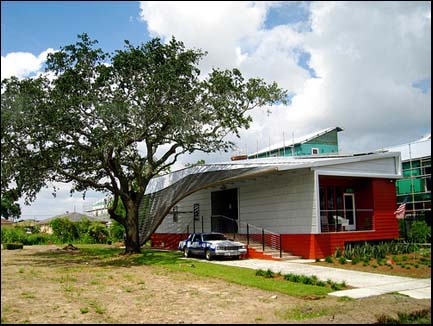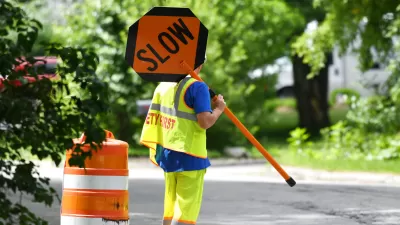Patrick L. Phillips, CEO of the Urban Land Institute, reflects on the state of rebuilding efforts in New Orleans on the fifth anniversary of Hurricane Katrina. He sees an impressive level of planning, momentum and cooperation among stakeholders.
 Each day closer to the five-year anniversary of Hurricane Katrina brings new analyses and commentaries gauging the progress made by New Orleans to get back on its feet. Whether measured in terms of new bars or refurbished schools, the consensus is that, on the whole, this city – 80 percent of it submerged for days following the August 29, 2005 storm – is on the rebound.
Each day closer to the five-year anniversary of Hurricane Katrina brings new analyses and commentaries gauging the progress made by New Orleans to get back on its feet. Whether measured in terms of new bars or refurbished schools, the consensus is that, on the whole, this city – 80 percent of it submerged for days following the August 29, 2005 storm – is on the rebound.
When the Urban Land Institute advisory service panel advised the city on a revival strategy, expanding and diversifying its economy was a core piece of the recommendations for long-term sustainability. The panel maintained that a recovery plan focused on restoring "what was" rather than rethinking "what could be" would cheat New Orleans out of a chance to be more appealing, and ultimately more competitive. In the years following the storm, there are encouraging signs that the people of New Orleans have chosen "what could be."
A Brookings Institute report released earlier this month points to several positives for the area's economy: relatively mild job loss during the recession (the area was cushioned by rebuilding funds); growth of "knowledge-based" jobs; higher wages (a BizJournals report found that New Orleans led the nation's metro areas in income growth in 2009); a growing middle class; continued strength in arts and cultural programs; improved public schools; and, while still significant, a decline in the number of vacant properties. Just last week, New Orleans Mayor Mitch Landrieu announced plans for more than 100 new public projects that will total nearly $640 million, including construction on the first portion of a $30 million riverfront park; recreational facilities, and community centers. This builds on more than 270 projects that were completed or nearly finished during former Mayor Ray Nagin's time in office.

What has been accomplished so far, what is underway, and what is planned are testaments to the tenacity and determination of all the city's stakeholders – those in public sector and the private sector, the businesses, civic organizations, nonprofits, neighborhood activists and individuals. The road back has not been without substantial conflict, but clearly, there is a desire not just to rebuild what was lost, but to make New Orleans a better place to live and work, to increase its chances of attracting new residents and workers. The proposed new medical research facility, plus the decision by a wind turbine blade manufacturer to locate in New Orleans are just two examples of how the area's economy is evolving beyond the traditional sectors of tourism, ports, oil and gas.
The city can keep its momentum going through careful consideration of how and where it grows, so that it continues to 1) become more accessible to residents and workers of a variety of incomes, age groups and household composition; and 2) more responsive to growing consumer demand for more energy-efficient and environmentally conscious places to live and work. This means sticking with a comprehensive strategy for development (and redevelopment) that conserves land and reduces the need to drive -- emphasizing development that integrates housing in a variety of price ranges, is close to employment and shopping, and is connected by transit.
Data from the Center for Neighborhood Technology (CNT) offers a glimpse at where New Orleans stands in this regard. Earlier this year, the center released new data measuring location costs for more than 330 metro areas across the U.S., including combined housing and transportation expenses, miles traveled for local trips, and vehicle carbon emissions. Although New Orleans is not among the nation's priciest markets, CNT found that the housing-transportation burden for the metro area remains high, totaling at least 45 percent of the income for the vast majority of residents.
The data also show the extent of car dependency in New Orleans: while those in the inner core drive less than 12,000 miles per year, those in the neighborhoods from just outside the core to the outlying edges drive 16,000 miles, even 18,000-plus miles per year for work and errands (nearly twice the national average). While 14 percent of downtown residents use public transit, the percentage drops to one percent or less for the suburbs. And, not surprisingly, the households farthest from major employment nodes have the highest carbon emissions. What this shows is the impact of sprawl in the suburbs, even in close-in suburbs, and even in a city with distinct land constraints.
As New Orleans continues the rebuilding process, how its suburbs grow is pivotal. Suburban growth in the 21st century does not have to be sprawl, not in New Orleans or other urban areas. In metro areas across the United States, the suburbs are where the growth will be, and in the suburbs, less land will have to be used to accommodate more people.
The need for more housing that is close to jobs, and the link between land use, driving, and environmental preservation all make a strong case for changing development patterns throughout urban regions, in the outlying areas as well as urban cores. In many ways, New Orleans is a city like no other, but in this regard, it is no different.
Patrick L. Phillips is the Chief Executive Officer of the Urban Land Institute (ULI). Phillips, a longtime member of ULI and a ULI trustee, has a career in the economic analysis of real estate and land use that spans more than 20 years. Prior to his position at ULI, he was President and Chief Executive Officer of ERA AECOM (formerly Economics Research Associates).He is a frequent speaker on urban development issues, and is the author or co-author of eight books and numerous articles.

Trump Administration Could Effectively End Housing Voucher Program
Federal officials are eyeing major cuts to the Section 8 program that helps millions of low-income households pay rent.

Planetizen Federal Action Tracker
A weekly monitor of how Trump’s orders and actions are impacting planners and planning in America.

Ken Jennings Launches Transit Web Series
The Jeopardy champ wants you to ride public transit.

California Invests Additional $5M in Electric School Buses
The state wants to electrify all of its school bus fleets by 2035.

Austin Launches $2M Homelessness Prevention Fund
A new grant program from the city’s Homeless Strategy Office will fund rental assistance and supportive services.

Alabama School Forestry Initiative Brings Trees to Schoolyards
Trees can improve physical and mental health for students and commnity members.
Urban Design for Planners 1: Software Tools
This six-course series explores essential urban design concepts using open source software and equips planners with the tools they need to participate fully in the urban design process.
Planning for Universal Design
Learn the tools for implementing Universal Design in planning regulations.
Ada County Highway District
Clanton & Associates, Inc.
Jessamine County Fiscal Court
Institute for Housing and Urban Development Studies (IHS)
City of Grandview
Harvard GSD Executive Education
Toledo-Lucas County Plan Commissions
Salt Lake City
NYU Wagner Graduate School of Public Service





























